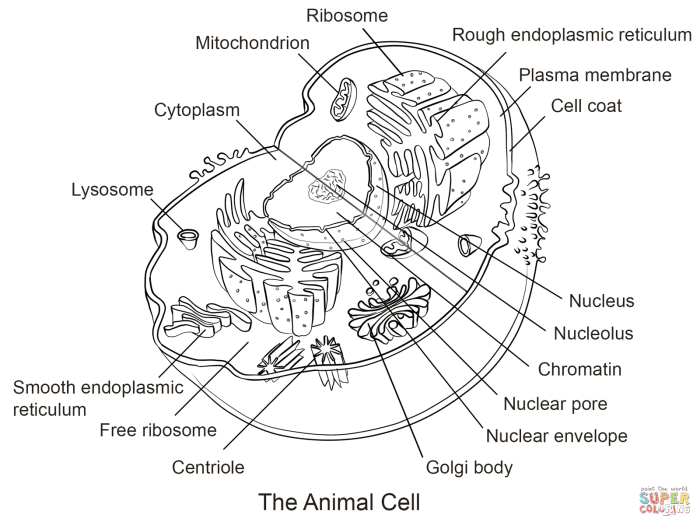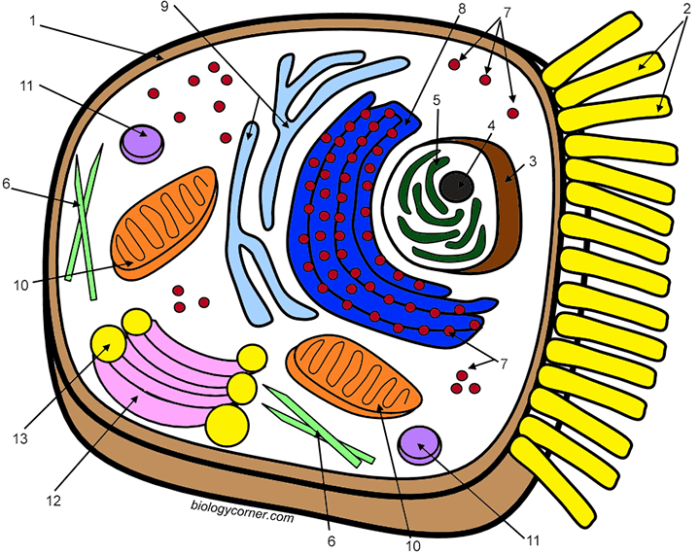Introduction to Animal Cell Structure and Function: Animal Cell Coloring Work Biology Center

Animal cell coloring work biology center – Animal cells, the fundamental building blocks of animals, are eukaryotic cells characterized by a complex internal organization. Understanding their structure and the function of their constituent organelles is crucial to comprehending the processes that govern life. This section will explore the major components of animal cells and their roles in maintaining cellular homeostasis and facilitating essential life processes.
The animal cell is enclosed by a selectively permeable plasma membrane, a vital structure responsible for maintaining the cell’s internal environment. This membrane is a fluid mosaic of phospholipids and proteins, regulating the passage of substances into and out of the cell, thus controlling the cell’s internal composition and preventing uncontrolled influx or efflux of essential molecules.
The Cell Membrane and Homeostasis
The cell membrane’s structure is critical for maintaining homeostasis, the state of internal stability necessary for cell survival. The phospholipid bilayer acts as a barrier, preventing the free passage of many molecules. Embedded proteins, however, facilitate selective transport, allowing specific molecules to cross the membrane via channels, carriers, or pumps. This selective permeability allows the cell to maintain optimal concentrations of ions, nutrients, and waste products, essential for various metabolic processes.
For example, the sodium-potassium pump actively maintains a higher concentration of potassium ions inside the cell and sodium ions outside, a gradient crucial for nerve impulse transmission. Disruptions to membrane integrity, such as damage from toxins or pathogens, can compromise homeostasis and lead to cell death.
Major Organelles and Their Functions
Animal cells contain a variety of organelles, each with a specialized function contributing to the overall cellular activity. These organelles work in a coordinated manner to maintain cellular life.
A summary of key organelles and their functions follows:
| Organelle | Function |
|---|---|
| Nucleus | Contains the cell’s genetic material (DNA), controls gene expression, and regulates cell division. |
| Ribosomes | Synthesize proteins based on the genetic code. |
| Endoplasmic Reticulum (ER) | Synthesizes lipids, modifies proteins, and transports molecules within the cell. The rough ER (with ribosomes) is involved in protein synthesis, while the smooth ER synthesizes lipids and detoxifies substances. |
| Golgi Apparatus | Processes, sorts, and packages proteins and lipids for secretion or delivery to other organelles. |
| Mitochondria | Generate ATP (adenosine triphosphate), the cell’s main energy currency, through cellular respiration. |
| Lysosomes | Contain enzymes that break down waste materials and cellular debris. |
| Cytoskeleton | Provides structural support and facilitates intracellular transport. |
The Nucleus and Cell Division
The nucleus is the control center of the cell, housing the cell’s genetic material, deoxyribonucleic acid (DNA). DNA is organized into chromosomes, which contain genes that encode the instructions for building and maintaining the cell. The nucleus plays a crucial role in cell division, ensuring that each daughter cell receives a complete and accurate copy of the genetic information.
During cell division (mitosis or meiosis), the DNA replicates, and the chromosomes condense and segregate, ensuring that each new cell inherits a complete set of chromosomes. The nuclear envelope, a double membrane surrounding the nucleus, breaks down during mitosis to allow access to the chromosomes, and reforms around the chromosomes in each daughter cell after division is complete.
Errors in DNA replication or chromosome segregation during nuclear division can lead to mutations or genetic abnormalities, potentially causing diseases or developmental problems. For example, aneuploidy, an abnormal number of chromosomes, is often associated with birth defects and cancers.
Animal Cell Coloring Activities

Coloring activities offer a valuable and engaging method for students to learn about the structure and function of animal cells. This approach combines visual learning with hands-on experience, promoting deeper understanding and retention of complex biological concepts. The following sections detail the design and implementation of a comprehensive animal cell coloring worksheet and activity, along with a discussion of its pedagogical benefits.
Animal Cell Coloring Worksheet Design, Animal cell coloring work biology center
The worksheet should depict a typical animal cell, accurately representing the relative size and location of major organelles. A clear, simple line drawing is preferable to a complex, detailed illustration to avoid overwhelming the student. The design should be visually appealing, using clear lines and ample space for labeling. Each organelle should be clearly numbered or lettered for easy correlation with the accompanying table.
| Organelle | Function | Suggested Color | Color Rationale |
|---|---|---|---|
| Cell Membrane | Regulates passage of substances into and out of the cell. | Dark Blue | Represents a barrier. |
| Nucleus | Contains genetic material (DNA). | Light Purple | Represents the control center. |
| Cytoplasm | Gel-like substance filling the cell. | Light Yellow | Represents the background. |
| Mitochondria | Produce energy (ATP). | Red | Represents energy production. |
| Ribosomes | Synthesize proteins. | Dark Green | Represents protein synthesis. |
| Endoplasmic Reticulum (ER) | Protein and lipid synthesis and transport. | Light Green | Represents a network of tubules. |
| Golgi Apparatus | Processes and packages proteins. | Orange | Represents processing and packaging. |
| Lysosomes | Digest waste materials. | Brown | Represents waste breakdown. |
Animal Cell Coloring Activity Implementation
The following steps Artikel a hands-on animal cell coloring activity suitable for a biology center environment. The activity is designed to be engaging and informative, catering to diverse learning styles.
Careful planning and organization are crucial for a successful hands-on activity. This ensures that all participants have the necessary materials and guidance to complete the activity effectively and safely.
- Materials: Animal cell coloring worksheets, colored pencils or crayons, reference materials (textbooks, diagrams), and optional: markers, highlighters.
- Procedure:
- Distribute worksheets and coloring materials to participants.
- Briefly review the major organelles of an animal cell and their functions.
- Guide participants to color each organelle according to the provided color scheme or their own creative interpretations, ensuring accuracy of location.
- Encourage participants to label each organelle using the worksheet’s numbering or lettering system.
- Facilitate a discussion about the functions of each organelle and their interactions within the cell.
- Optional: Allow participants to create a short presentation or poster summarizing their learning.
Pedagogical Benefits of Animal Cell Coloring Activities
Coloring activities provide several pedagogical advantages for learning about animal cells. They cater to different learning styles, making complex information more accessible and memorable. The visual nature of the activity enhances understanding of spatial relationships between organelles. The act of coloring itself promotes engagement and active learning, improving knowledge retention compared to passive learning methods. Furthermore, the activity encourages creativity and self-expression, fostering a positive learning environment.
The hands-on nature of the activity promotes kinesthetic learning, benefiting students who learn best through physical activity. Finally, the collaborative aspect of the activity, if implemented as a group project, enhances communication and teamwork skills.
Completing animal cell coloring work at the biology center can be a fun and educational experience. For a slightly different approach to cell structures, you might find inspiration in the delightful illustrations available at coloring pages alphabet animals ; observing the detail in these simpler forms can help hone your observational skills, beneficial when returning to the more complex diagrams of animal cells.
Ultimately, both activities enhance your understanding of biological forms.

